- Telespazio Belgium, Darmstadt, Germany
The asymptotic radiative transfer theory is used to derive the analytical approximation for the broadband albedo of pure and polluted snow surfaces. The technique for the determination of the effective snow grain size and also the snow specific surface area from the shortwave broadband albedo measurements is proposed.
Introduction
The surface broadband albedo (BBA) α is defined as the ratio of the surface upward radiation flux to the downward radiation flux within a certain wavelength range. If the wavelength region
The main task of this work is to propose simple parametrizations of pure and polluted snow broadband albedo in terms of snow microstructure. The derived equations can be used both for the estimation of clean snow microstructure and also in the Global Circulation Models (GCMs), which require simple functions to compute band averaged albedo (Marshall and Oglesby, 1994). There are numerous parameterizations of broadband albedo of pure snow and snow containing various impurities (Marshall and Warren, 1987; Marshall, 1989; Brun et al., 1992; Pirazzini, 2009; Gardner and Sharp, 2010; Dang et al., 2015; Kokhanovsky et al., 2020). A comprehensive review of various snow albedo parameterizations is given by Dang et al. (2015). The difference of our work from other parametrizations is that it is based on the new update on the ice refractive index in the visible (Picard et al., 2016). Also we used the asymptotic radiative transfer theory (Kokhanovsky and Zege, 2004), which makes it possible to propose highly accurate exponential approximation for the broadband pure snow albedo in terms of a single parameter—the effective attenuation scale (EAS). The parametrization of polluted snow albedo in terms of EAS and pollution load/type is also proposed.
Theory
Pure Snow
The snow broadband albedo is defined as (Aoki et al., 2011)
where
where the corersponding parameters are given in Table 1. The multiplication of the function

TABLE 1. The coefficients of approximation given by Eq. (2) (Kokhanovsky et al., 2020, with corrections for misprints).
The spectral albedo of clean plane-parallel snow surfaces is given by (Kokhanovsky et al., 2020):
where
is the effective attenuation scale (EAS),
where the shape factor
The following expression for the escape function proposed by Kokhanovsky et al. (2021) is used:
Let us substitute Eqs. 2, 3 into Eq. 1 and account for the fact that
where
and
where the coefficients for various spectral intervals are given in Table 2. We have used the data for the imaginary part of ice refractive index obtained by Picard et al. (2016) (http://pp.ige-grenoble.fr/pageperso/picardgh/ice_absorption/). The substitution of Eqs. 2 and (9) in Eq. 8 makes it possible to derive the analytical expression for the parameter p. Namely, it follows:
where
This integral can be evaluated analytically. In particular, one derives:
where
The values
Eq. 7 is valid at small values of the product η = ps. To extend the applicability of Eq. 7 with respect to the value of the parameter η, we propose to use the following parameterization of the UV and visible albedo:
where the value of p is given by Eq. 10. Eq. 7 follows from Eq. 17 at η
Eq. 17 follows from Eq. 18 at

TABLE 3. The coefficients of approximation given by Eq. (18).
The dependence of the visible (0.3–0.7
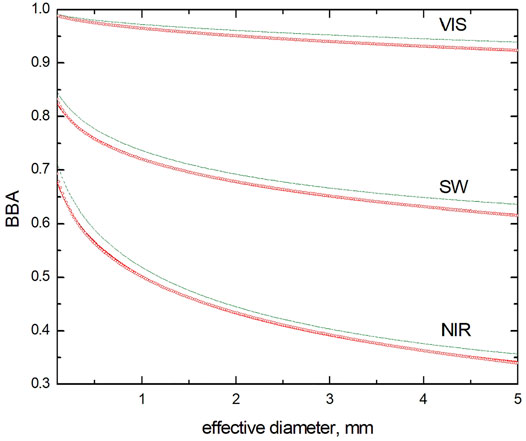
FIGURE 1. The dependence of the VIS (0.3–0.7 μm), SW (0.3–2.5 μm) and NIR (0.7–2.5 μm) broadband albedo of pure snow on the effective snow grain diameter calculated using Eq. 18 (red solid lines), the parametrization by Dang et al. (2015) (upper green lines) and results of numerical calculations using Eq. 1 (red circles).
We have found that the difference between numerical calculations using Eq. 1 and analytical Eq. 18 with account for data given in Table 3 is smaller than 1% for the shortwave and visible albedo and it is smaller than 2% for the NIR albedo at the diameters d > 0.1 mm characteristic for terrestrial snow covers. This difference is smaller that the respective error of the BBA measurement. The difference between the parameterization given by Eq. 18 and former parametrization given by Dang et al. (2015) is below 2% in the visible, 3% in the shortwave, and 6% in the NIR regions with our parametrization providing smaller albedos for a given size of ice grains. This is mostly due to the fact that the new compilation of the ice refractive index (Picard et al., 2016) gives larger values of the imaginary part of ice refractive index in the VIS/NIR part of the electromagnetic spectrum as compared to the corresponding values given by Warren and Brandt (2008). Also our model is based on the assumption that ice grains are irregularly shaped as compared to the parameterization for snow BBA based on the model of ice spheres proposed by Dang et al. (2015). The effective ice grain diameter used by us is defined as
Eq. 18 can be used in the simplifaction of the corresponding blocks in Global Circulation Models (GCMs). It follows from Eq. 18 that the values of BBA of snowpacks with various microstructure coinside, if the effective attenuation scale s is the same. Also our new snow BBA albedo parametrization can be used for the determination of the snow BBA for given sizes of ice grains and illumination conditions and also for the solution of inverse problems of snow optics. In particular, it follows for the effective pure snow grain diameter from Eq. 18:
where
The dependence of the effective ice grain diameter on the SW BBA derived using Eq. 19 at u = 1 corresponding to the case of overcast sky (spherical or white sky BBA (Kokhanovsky et al., 2019)) is given in Figure 2, where the correspondence between SW BBA values and international snow classification (Fierz et al., 2009) is also presented.
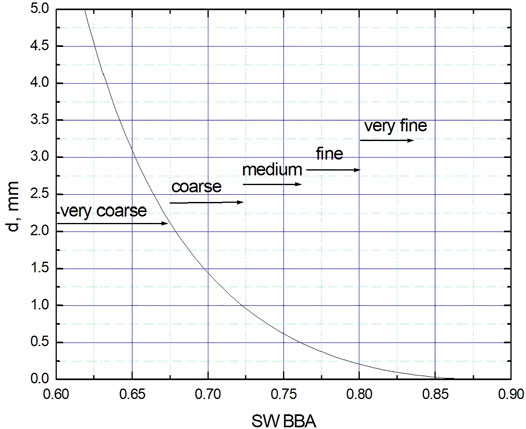
FIGURE 2. The correspondence between values of the effective ice grain diameter and SW BBA of pure snow. The ranges of SW BBA corresponding to the international classification (Fierz et al., 2009) for the snow grain sizes are given as well.
We show the temporal behaviour of the SW BBA as measured by the Programme for Monitoring of the Greenland Ice Sheet (PROMICE) network of pyranometers (Fausto et al., 2021) at the East GRIP (EGP) location (75.6N, 36 W) in Greenland and also temporal variation of the ice grain diameter derived from Eq. 19 in Figure 3. Also in situ ground measurements of the grain diameter as reported by Kokhanovsky et al. (2019) for July 8, 9, and 13 (2018) are given. One can see that the SW broadband albedo at EGP does not change considerably for the time interval studied. It is close to 0.8. The grain diameter is in the range 0.1–0.4 mm for most of cases. The diameters of grains derived from in situ measurements are close to those derived from Eq. 19.
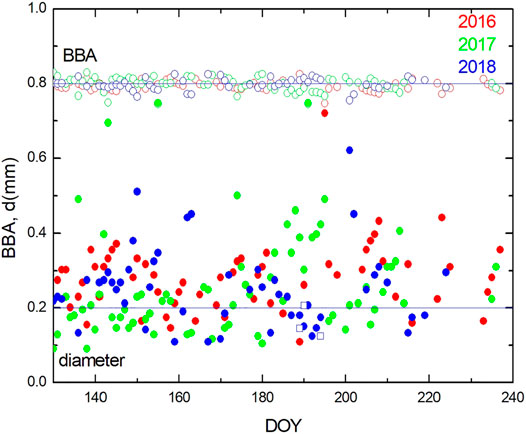
FIGURE 3. The daily-averaged shortwave broadband albedo measured at the EGP PROMICE station (open circles) and ice grain diamaters derived using Eq. 19 for years 2016–2018 (filled circles) as the function of the Day Of Year (DOY). Boxes show the effective ice grain diameters measured in situ at the site on July 8, 9 and 13 (2018).
The snow specific surface area derived from shortwave BBA measurements is given in Figure 4. It is mostly in the range 15–45 kg/
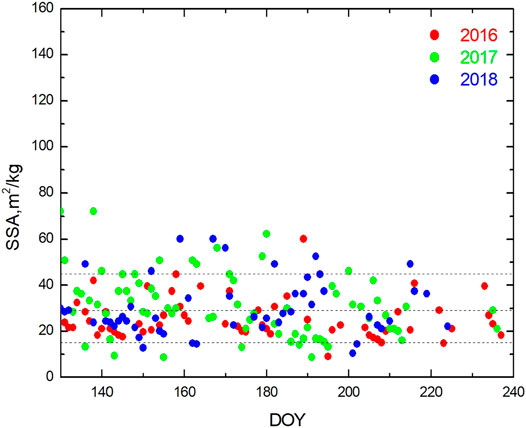
FIGURE 4. The snow specific surface area at the EGP site derived from the daily shortwave albedo measurements for years 2016–2018.
The intercomparison of the SSA determined from the SW BBA observations and those performed in the vicinity of the EGP station using NIR hemispherical snow reflectance observations under artificial light illumination conditions (Gallet et al., 2009) is given in Figure 5. Further details on the measurements of the SSA at the EGP station using NIR observations are given by Kokhanovsky et al. (2019). It follows that SW BBA and NIR measurements provide similar values of the SSA. This is due to the fact that both BBA and spectral snow reflectance measurements provide the same quantity–the effective snow grain diameter, which is used to derive the snow specific surface area. The difference in the measurements is due to the local variation of the SSA as shown in Figure 5 and also due to different average light penetration depths for the NIR (at 1.31 μm) hemispherical reflectance and SW BBA measurements.
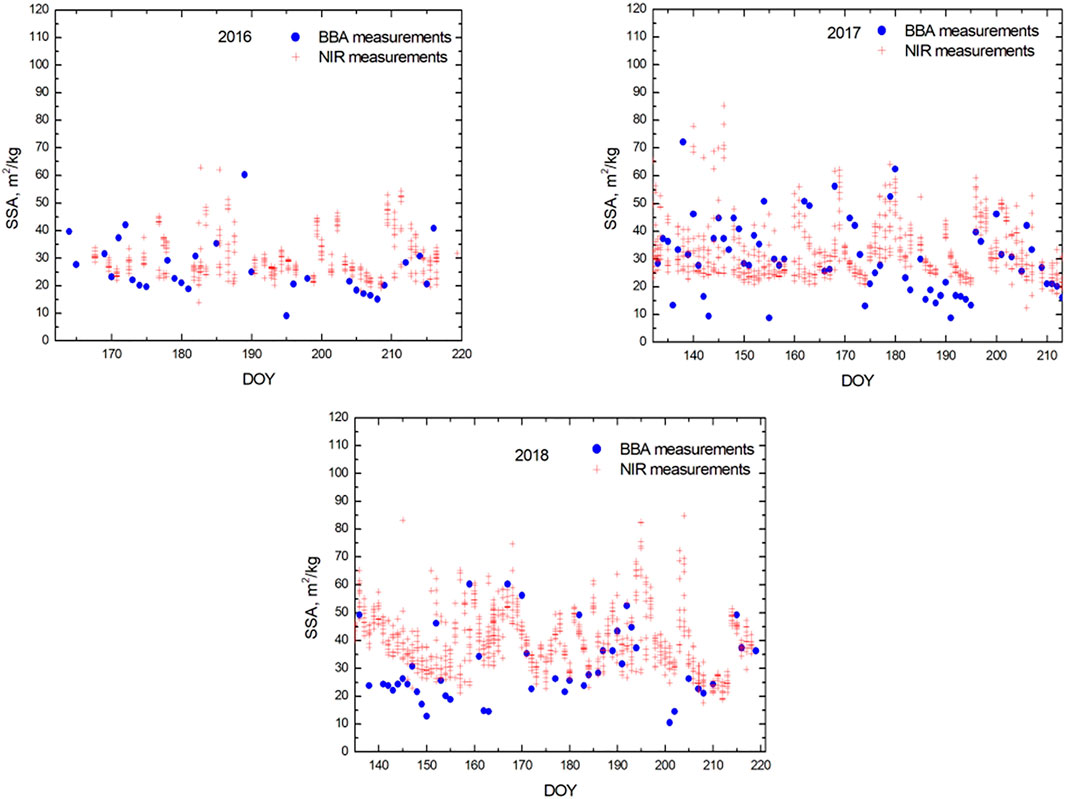
FIGURE 5. The temporal behaviour of SSA derived from NIR reflectance and SW BBA measurements at the EGP site in Greenland for years 2016–2018. The BBA and NIR observations are not absolutely collocated in space and time domains. The NIR measurements are performed in the vicinity of the BBA observations on a 100 m transect (10 stations for every day at a given time). The average daily BBA values are presented.
The aveage values of shortwave broadband albedo measured at EGP site for 2016–2018 and average values of the ice grain diameter and snow specific surface area (derived using daily SW BBA measurements) are given in Table 4. It appears that the interannual variations are quite small at the site.

TABLE 4. The average values of the measured shortwave broadband albedo and derived ice grain diameter d and SSA at the EGP location in Greenland for several years. The average values for 2016–2018 time period are given as well.
We compare the average values of the SSA for the 2 months (June, July) derived at the EGP site from BBA measurements for several years and also similar results from NIR measurements in Table 5. One can see that both datasets produce similar results for the average values of BBA. Clearly, the determination of the SSA from routine BBA measurements requires a fraction of time as compared to the hemispherical snow reflectance measurements under the artificial light (a laser diode) illumination conditions.

TABLE 5. The average values of the SSA at the EGP location in Greenland derived using SW BBA and NIR hemispherical reflectance measurements in June–July (2016–2018). The number of days, when BBA and NIR hemispherical measurements have been performed do not coincide. The values of SSA above 60
Polluted Snow
Let us consider the polluted snow now. Then it follows for the spectral albedo (Kokhanovsky et al., 2021):
where
and light scattering effects by pollutants are ignored as compared to light scattering by ice grains. Eq. 3 follows from Eq. 20 at c = 0 as it should be.
One can derive using Eqs. 1, 20 for the shortwave BBA in the spectral range 0.3–2.5 μm:
where
The parameter Q gives the ratio of incident light flux in the band 0.3–0.7 μm to that at the NIR band 0.7–2.5 μm. It appears that Q = 1.08 and, therefore, one can assume that the SW albedo is approximately equal to the average of VIS and NIR albedos (similar to the case of pure snow SW BBA discussed above). The NIR BBA
It follows from Eq. 20 for the UV and visible albedo of polluted snow:
assuming that
where
The numerical simulations show that the parameter
where the corresponding constants m and are γ given in Table 6. The constant

TABLE 6. The coefficients of approximation given by Eq. (28).
To extend the area of applicability of Eq. 26 we shall use an exponential approximation:
where
Eq. 29 is the final parametrization of the polluted snow visible broadband albedo. One can see that the visible BBA depends on the effective absorption scale s (d,
The shortwave snow albedo of polluted snow can be derived using analytical Eqs. 18, 23, 29. Namely, it follows:
where
The accuracy of this approximation as compared to the numerical integration using Eq. 1 is shown in Figure 6 for snow contaminated by soot aerosol and the same solar zenith angle as in Figure 1. It has been assumed in calculations that (Kokhanovsky and Zege, 2004): B = 1.8, x = 1, and
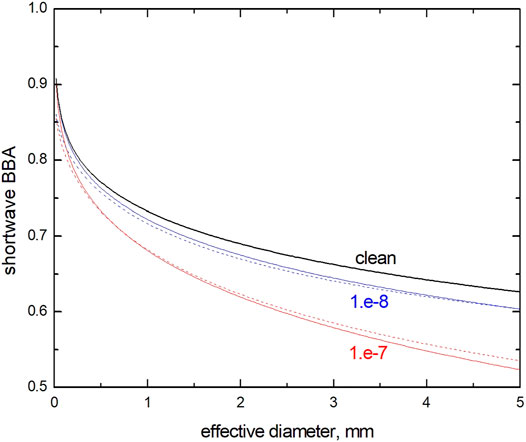
FIGURE 6. The dependence of the shortwave BBA on the efefctive diameter of grains at the relative volumetric concentration of pollutants c equal to

TABLE 7. The parameters of dust-loaded snow (Kokhanovsky et al., 2021).
The spectral albedo measurements in the range 400–900 nm as reported by Kokhanovsky et al. (2021) can be used to estimate the shortwave snow albedo. This is possible because the parameters q and s (Eq. 29) can be assessed from spectral measurements. The SW BBA for the polluted snow cases investigated by Kokhanovsky et al. (2021) is presented in Table 7. The corresponding values were derived using Eq. 31 and data presented in Table 7.
Conclusion
In this work new simple approximations for the snow broadband albedo are proposed. The derivations are based on the asymptotic radiative transfer for plane - parallel homogeneous semi—infinite snow surfaces. The effects of underlying surfaces and snow vertical inhomogeneity are not accounted for. The derived equations can be corrected for slope and sensor tilts as discussed by Weiser et al. (2016).
The standard pyranometers with a glass dome measure in the spectral range 0.3–2.8 μm. Both the snow reflectivity and solar incident flux are small in the spectral range 2.5–5.0 μm. Therefore, our parametrizations can be used in the spectral ranges 0.3–2.8 and 0.3–5.0 μm as well. The accuracy of asymptotic radiative transfer theory decreases with increase of light absorption in snow. Therefore, the accuracy of the visible and shortwave albedo parametrization is higher as compared to that of NIR albedo parameterization, especially for aged polluted snow with large ice grains (Figure 6). The developed exponential parametrizations of pure and polluted snow albedo can be used in the Golobal Circulation Models and also for the estimation of the snow grain size/snow specific surface area from pure snow broadband albedo measurements. Also we demonstrate a possibility for the determination of the shortwave broadband albedo from spectral albedo measurements in narrow spectral intervals (say, 400–900 nm).
The parameterizations refer to the plane of the blue sky albedo. The results for the spherical (white sky) albedo can be derived from equations given above assuming that the escape function u = 1 (Kokhanovsky et al., 2019).
Data Availability Statement
The raw data supporting the conclusion of this article will be made available by the authors, without undue reservation.
Author Contributions
The author confirms being the sole contributor of this work and has approved it for publication.
Conflict of Interest
The author declares that the research was conducted in the absence of any commercial or financial relationships that could be construed as a potential conflict of interest.
The handling editor declared past collaborations with the author.
Publisher’s Note
All claims expressed in this article are solely those of the authors and do not necessarily represent those of their affiliated organizations, or those of the publisher, the editors and the reviewers. Any product that may be evaluated in this article, orclaim that may be made by its manufacturer, is not guaranteed or endorsed by the publisher.
Acknowledgments
Data from the Programme for Monitoring of the Greenland Ice Sheet (PROMICE) were provided by the Geological Survey of Denmark and Greenland (GEUS) at http://www.promice.dk (Fausto et al., 2021). The author is grateful to two reviewers for useful suggestions.
References
Aoki, T., Hachikubo, A., and Hori, M. (2003). Effects of snow physical parameters on shortwave broadband albedos. J. Geophys. Res. 108, 4616. doi:10.1029/2003JD003506
Aoki, T., Kuchiki, K., Niwano, M., Kodama, Y., Hosaka, M., and Tanaka, T. (2011). Physically based snow albedo model for calculating broadband albedos and the solar heating profile in snowpack for general circulation models. J. Geophys. Res. 116, D11114. doi:10.1029/2010JD015507
Brun, E., David, P., Sudul, M., and Brunot, G. (1992). A numerical model to simulate snow-cover stratigraphy for operational avalanche forecasting. J. Glaciol. 38, 13–22. doi:10.1017/s0022143000009552
Dang, C., Brandt, R. E., and Warren, S. G. (2015). Parameterizations for narrowband and broadband albedo of pure snow and snow containing mineral dust and black carbon. J. Geophys. Res. Atmos. 120, 5446–5468. doi:10.1002/2014JD022646
Di Mauro, B., Fava, F., Ferrero, L., Garzonio, R., Baccolo, G., Delmonte, B., et al. (2015). Mineral dust impact on snow radiative properties in the European Alps combining ground, UAV, and satellite observations. J. Geophys. Res. Atmos. 120, 6080–6097. doi:10.1002/2015JD023287
Domine, F., Albert, M., Huthwelker, T., Jacobi, H.-W., Kokhanovsky, A. A., Lehning, M., et al. (2008). Snow physics as relevant to snow photochemistry. Atmos. Chem. Phys. 8, 171–208. doi:10.5194/acp-8-171-2008
Dumont, M., Arnaud, L., Picard, G., Libois, Q., Lejeune, Y., Nabat, P., et al. (2017). In situ continuous visible and near-infrared spectroscopy of an alpine snowpack. The Cryosphere 11, 1091–1110. doi:10.5194/tc-11-1091-2017
Fausto, R. S., van As, D., Mankoff, K. D., Vandecrux, B., Citterio, M., Ahlstrøm, A. P., et al. (2021). PROMICE automatic weather station data. Earth Syst. Sci. Data Discuss. [preprint]in review https://doi.org/10.5194/essd-2021-80
Fierz, C., Armstrong, R. L., Durand, Y., Etchevers, P., Greene, E., McClung, D. M., et al. (2009). The International Classification for Seasonal Snow on the Ground. IHP-VII Technical Documents in Hydrology N°83, IACS Contribution N°1. Paris: UNESCO-IHP.
Gallet, J.-C., Domine, F., Zender, C. S., and Picard, G. (2009). Measurement of the specific surface area of snow using infrared reflectance in an integrating sphere at 1310 and 1550 nm. The Cryosphere 3, 167–182. doi:10.5194/tc-3-167-2009
Gardner, A. S., and Sharp, M. J. (2010). A review of snow and ice albedo and the development of a new physically based broadband albedo parameterization. J. Geophys. Res. 115, F01009. doi:10.1029/2009JF001444
Green, R. O., Painter, T. H., Roberts, D. A., and Dozier, J. (2006). Measuring the expressed abundance of the three phases of water with an imaging spectrometer over melting snow. Water Resour. Res. 42, W10402. doi:10.1029/2005WR004509
Grenfell, T. C., and Perovich, D. K. (2008). Incident spectral irradiance in the Arctic Basin during the summer and fall. J. Geophys. Res. 113, D12117. doi:10.1029/2007JD009418
Kokhanovsky, A. A. (2006). Scaling constant and its determination from simultaneous measurements of light reflection and methane adsorption by snow samples. Opt. Lett. 31, 3282–3284. doi:10.1364/ol.31.003282
Kokhanovsky, A. A., and Zege, E. P. (2004). Scattering optics of snow. Appl. Opt. 43, 1589–1602. doi:10.1364/ao.43.001589
Kokhanovsky, A., Box, J. E., Vandecrux, B., Mankoff, K. D., Lamare, M., Smirnov, A., et al. (2020). The determination of snow albedo from satellite measurements using fast atmospheric correction technique. Remote Sensing 12, 234. doi:10.3390/rs12020234
Kokhanovsky, A., Di Mauro, B., Garzonio, R., and Colombo, R. (2021). Retrieval of dust properties from spectral snow reflectance measurements. Front. Environ. Sci. 9, 42. doi:10.3389/fenvs.2021.644551
Kokhanovsky, A., Lamare, M., Danne, O., Brockmann, C., Dumont, M., Picard, G., et al. (2019). Retrieval of snow properties from the Sentinel-3 Ocean and Land Colour Instrument. Remote Sensing 11, 2280. doi:10.3390/rs11192280
Libois, Q., Picard, G., Dumont, M., Arnaud, L., Sergent, C., Pougatch, E., et al. (2014). Experimental determination of the absorption enhancement parameter of snow. J. Glaciol. 60, 714–724. doi:10.3189/2014j0g14j015
Marshall, S. E. (1989). A physical parameterization of snow albedo for use in climate models, NCAR cooperative thesis 123. Medium Ævum 58, 175. Natl. Cent. for Atmos. Res., Boulder, Colo. doi:10.2307/43632553
Marshall, S. E., and Warren, S. G. (1987). Parameterization of snow albedo for climate models, in Large scale effects of seasonal snow cover, IAHS Publ., vol. 166, edited by B. E. Goodison, R. G. Barry, and J. Dozier, pp. 43–50, International Association of Hydrological Sciences, Washington, D. C.
Marshall, S., and Oglesby, R. J. (1994). An improved snow hydrology for GCMs. part 1: Snow cover fraction, albedo, grain size, and age. Clim. Dyn. 10, 21–37. doi:10.1007/bf00210334
McArthur, L. J. B. (2005). “Baseline Surface Radiation Network (BSRN),” in Operations Manual Version 2.1, WCRP-121. WMO/TD-No. 1274, Geneva.
Meinander, O., Kontu, A., Lakkala, K., Heikkilä, A., Ylianttila, L., and Toikka, M. (2008). Diurnal variations in the UV albedo of arctic snow. Atmos. Chem. Phys. 8, 6551–6563. doi:10.5194/acp-8-6551-2008
Nolin, A. W., and Dozier, J. (1993). Estimating snow grain size using AVIRIS data. Remote sensing Environ. 44 (2-3), 231–238. doi:10.1016/0034-4257(93)90018-s
Picard, G., Libois, Q., and Arnaud, L. (2016). Refinement of the ice absorption spectrum in the visible using radiance profile measurements in Antarctic snow. The Cryosphere 10, 2655–2672. doi:10.5194/tc-10-2655-2016
Pirazzini, R. (2009). Challenges in snow and ice albedo parameterizations. Geophysica 45 (1-2), 41–62.
Pirazzini, R. (2004). Surface albedo measurements over Antarctic sites in summer. J. Geophys. Res. 109, D20118. doi:10.1029/2004JD004617
Skiles, S. M., Flanner, M., Cook, J. M., Dumont, M., and Painter, T. H. (2018). Radiative forcing by light-absorbing particles in snow. Nat. Clim Change 8 (11), 964–971. doi:10.1038/s41558-018-0296-5
Skiles, S. M., and Painter, T. H. (2019). Toward understanding direct absorption and grain size feedbacks by dust radiative forcing in snow with coupled snow physical and radiative transfer modeling. Water Resour. Res. 55, 7362–7378. doi:10.1029/2018WR024573
Keywords: snow, albedo, snow specific surface area, radiative transfer, ice grain diameter
Citation: Kokhanovsky AA (2021) The Broadband Albedo of Snow. Front. Environ. Sci. 9:757575. doi: 10.3389/fenvs.2021.757575
Received: 12 August 2021; Accepted: 17 September 2021;
Published: 22 October 2021.
Edited by:
Dmitry Efremenko, Helmholtz Association of German Research Centers (HZ), GermanyCopyright © 2021 Kokhanovsky. This is an open-access article distributed under the terms of the Creative Commons Attribution License (CC BY). The use, distribution or reproduction in other forums is permitted, provided the original author(s) and the copyright owner(s) are credited and that the original publication in this journal is cited, in accordance with accepted academic practice. No use, distribution or reproduction is permitted which does not comply with these terms.
*Correspondence: Alexander A. Kokhanovsky, QWxleGFuZGVyLktva2hhbm92c2t5QHRlbGVzcGF6aW8uYmU=
 Alexander A. Kokhanovsky
Alexander A. Kokhanovsky
